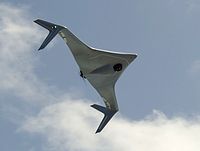
Photo from wikipedia
Farming is the major profession in several republics for centuries. However, due to the immigration of individuals from rural to urban, there is prevention in farming. The use of modern… Click to show full abstract
Farming is the major profession in several republics for centuries. However, due to the immigration of individuals from rural to urban, there is prevention in farming. The use of modern technology in the precision agriculture field increases productivity and also improves the exports of a country. The productivity may suffer due to different environmental factors, diseases and insects attacks on the crops, especially tomatoes. The target area (i.e. the affected crops area due to environmental factors) identification and delivery of timely information about diseases in the crops to the ground station are mandatory to make the precautionary measurements. In flying sensor networks, the localization and clustering of multiple unmanned aerial vehicles for target areas identification is a challenging task due to energy constraints, communication range, frequent change in topology, link expiration and high mobility. In this article, we proposed the localization and clustering of multiple unmanned aerial vehicles for the identification of affected target areas in the tomato crop field. The localization of unmanned aerial vehicles depends on the weights of environmental factors, that is, relative humidity, soil moisture, temperature, light intensity, NPK (nitrogen (n), phosphorus (p) and potassium (k)) and power of hydrogen (pH). A honey bee optimization approach is used for the localization and formation of multiple unmanned aerial vehicles’ cluster to accurately identify the target areas. The performance of our bio-inspired approach is compared in terms of communication overhead, packet delivery ratio, mean end-to-end delay and energy consumption with the existing swarm intelligence–based schemes and validated via a simulation. The simulation result shows that the bio-inspired approach performs better among the selected approaches.
Journal Title: International Journal of Distributed Sensor Networks
Year Published: 2021
Link to full text (if available)
Share on Social Media: Sign Up to like & get
recommendations!